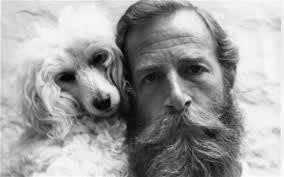One of Britain's most internationally acclaimed artists, Alan Davie is the most important Scottish artist of the twentieth century. He was the first British painter and arguably the first European artist, to realise the vitality and importance of American Abstract Expressionism. In 1948 he saw the Jackson Pollock paintings from Peggy Guggenheim’s collection in Venice and he was inspired to begin painting on a much grander scale in an aggressive and dynamic style.
Born on September 28, 1920 in Grangemouth, Scotland, Alan Davie was educated at the Edinburgh College of Art in the late 1930s. After World War II he explored a diverse range of activities. He earned his living by making jewellery, he worked as a jazz musician and he wrote poetry. Davie travelled widely and was impressed by other painters of the period such as Paul Klee, Jackson Pollock and Joan Miró.
Throughout his life Alan Davie drew and painted obsessively, producing works of startling originality, daring and vitality. The paintings are a complex yet joyous celebration of creativity that combine the expressive freedom of abstraction with an extensive roster of influences including Jungian psychoanalysis, Pictish stone symbols and his lifelong passion for music. He was influenced by a wide range of signs, symbols and words derived from different world cultures and in particular his painting style owes much to his affinity with Zen. Strongly inspired by Zen philosophies, he assimilated the spontaneity which Zen emphasises. As a result his paintings consist of intuitive and spontaneous compositions painted with obsessive mark-making to form enigmatic images that slip in between representation and abstraction. Davie attempted to paint as spontaneously and automatically as possible which was intended to bring forth elements of his unconscious. In this way he shared a vision with surrealist painters such as Joan Miró.
Alan Davie represented Britain at the Venice Biennale in 1958 and was for years shown by the Gimpel Family in London. During the 1960s, both in his paintings and coloured lithographs, the artist presented the universal signs and symbols with increasing clarity at the expense of gestural handling. Davie became an artistic shaman, depicting a synthesis of mythologies from a variety of cultures for a modern civilisation devoid of its own myths. Falling somewhat out of favour in the late twentieth-century, the artist has recently found a whole new base of younger admirers and is extremely collectable. His work can be found in private and public collections worldwide, notably Tate Britain in London, The Museum of Modern Art in New York, the Peggy Guggenheim Museum in Venice and the Stedelijk Museum in Amsterdam. Alan Davie was elected a Senior Royal Academician in 2012. He died in Hertfordshire, England on April 5, 2014 at the age of 93.

